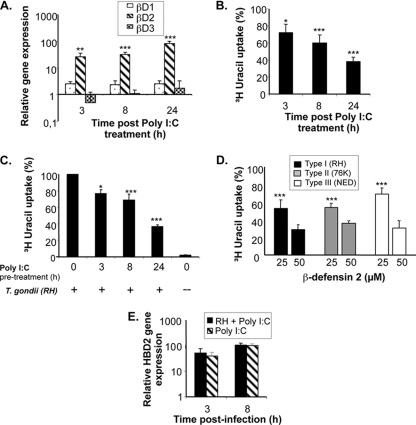Fig. 5.
Antimicrobial effect of HBD2 against type I T. gondii. (A) Poly(I:C) induces HBD2 gene expression. IEC were stimulated with poly(I:C) (50 μg/ml) for 3 h, 8 h, and 24 h, followed by RNA extraction. First-strand cDNA was synthesized using oligo(dT) primers and a RevertAid H Minus cDNA synthesis kit (Fermentas). Quantitative PCRs for HBD1, HBD2, and HBD3 were performed as described in the legend to Fig. 4. ***, P < 0.0001. (B) Antimicrobial effect of poly(I:C)-induced HBD2 on type I T. gondii. Three-, eight-, and 24-hour culture supernatants of poly(I:C) (50 μg/ml)-induced IEC were incubated for 2 h with type I T. gondii, along with the addition of 2.5 μCi of [3H]uracil/well (Amersham). Supernatants were then analyzed for uptake of [3H]uracil by these parasites. The data are represented as percent [3H]uracil uptake in comparison to the level for non-poly(I:C)-treated counterparts. ***, P < 0.0001; *, P < 0.05. (C) Decrease in viability of type I parasites in IEC pretreated with poly(I:C). IEC were pretreated with poly(I:C) (50 μg/ml) for 3, 8, and 24 h. At each time point, the cells were infected with type I T. gondii, followed by the addition of 2.5 μCi of [3H]uracil/well. After 24 h of infection, cells were analyzed to measure [3H]uracil by intracellular parasites. The data are represented as percent [3H]uracil uptake in comparison to the level for non-poly(I:C)-treated counterparts. ***, P < 0.0001; *, P < 0.05. (D) Antimicrobial effect of synthetic HBD2 peptide on T. gondii parasites. T. gondii parasites were pretreated at 25 μM and 50 μM concentrations of HBD2 (Peptanova, Germany) for 2 h. Parasites were then washed and infected to IEC monolayers along with the addition of 2.5 μCi of [3H]uracil/well (Amersham). The data are represented as percent [3H]uracil uptake by type I parasites compared to the level for non-HBD2-treated counterparts. ***, P < 0.0001. (E) Lack of ability to suppress poly(I:C)-induced HBD2 by type I (RH) parasites. IEC were infected with RH parasites for a period of 24 h, followed by stimulation with poly(I:C) (50 μg/ml) for 3 and 8 h. Cells treated with only poly(I:C) were used as a positive control, and noninfected and nonstimulated cells were used as a negative control. Quantitative PCR was performed on cDNA obtained from these cells for expression of the HBD2 gene.

